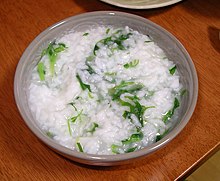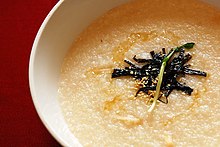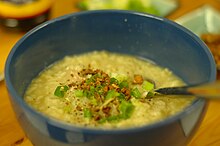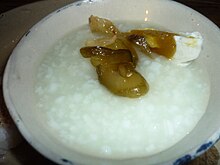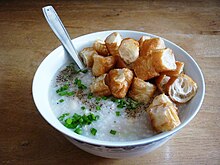:
.
:
:
Click here for more Pork on ChefsOpinion
:
Click here for more Pig on ChefsOpinion
:
Click here for more Congee on ChefsOpinion
:
:
P.S.
There is an extensive article about congee from around the world below the following pictures
:
:
Bon Appétit ! Life is Good !
:
:
:
:
:
:
:
:
:
:
Preparation :
To read instructions, hover over pictures
To enlarge pictures and read instructions, click on pictures
:
:
:
- simmer 5 lbs of pigs feet in lightly salted water until tender
- remove the meat from the stock, cut into bite-size pieces (there should be about 2 qt of stock at this point)
- add rice to the stock and cook until the porridge has the preferred texture. (The amount of rice and the cooking time depends on your preference – some folks like it thick, some like it watery, some like the rice falling apart, others prefer some bite, etc…….
- in the meantime, slice and fry 4 medium-size onions until crisp, remove to a absorbent paper
- ladle the porridge into 4 deep bowls, top with the diced pork, drizzle with sesame oil, chili oil and soy sauce to taste, sprinkle with finely sliced scallions and the fried onion
- Pork Congee – (猪肉粥) – (Pork Porridge)
- Pork Congee – (猪肉粥) – (Pork Porridge)
- Pork Congee – (猪肉粥) – (Pork Porridge)
- Pork Congee – (猪肉粥) – (Pork Porridge)
- Pork Congee – (猪肉粥) – (Pork Porridge)
- The Men You Please………
:
:
(Excerpt from Wikipedia)
:
Congee or conjee (/ˈkɒndʒi/) is a type of rice porridge or gruel popular in many Asian countries. When eaten as plain rice congee, it is most often served with side dishes. When additional ingredients such as meat, fish, and flavourings are added while preparing the congee, it is most often served as a meal on its own, especially for persons who are ill. Names for congee are as varied as the style of its preparation. Despite its many variations, it is usually a thick porridge of rice largely disintegrated after prolonged cooking in water.
The word congee comes from Tamil கஞ்சி (kanji), a prominent food of ancient Tamil people of Ancient India. The English form may have arrived in the language via Portuguese traders. The food may have its origins attributed to koozh, a porridge made of millet that was a staple dish of the ancient Tamil people.
In China, thick congee was known as 饘, zhān or 糜, mí, and thin congee as 鬻, zhù or 酏, yí.
Congee is easy to digest and very simple to cook.
Preparation
To prepare the dish, rice is boiled in a large amount of water until it softens significantly. Congee can be made in a pot or in a rice cooker. Some rice cookers have a “congee” setting, allowing it to be cooked overnight. The type of rice used can be either short- or long-grain, depending on what is available and regional cultural influences. Culture also often dictates the way congee is cooked and eaten.
In some cultures, congee is eaten primarily as a breakfast food or late supper; in others, it is eaten as a substitute for rice at other meals. It is often considered particularly suitable for the sick as a mild, easily digestible food.
By country
Burma
In Burma (now called Myanmar), rice congee is called ဆန်ပြုတ် hsan byok [sʰàmbjoʊʔ], literally “boiled rice”. It is very thin and plain porridge, often made with just rice and water, but sometimes with chicken or pork stock and served with a simple garnish of chopped spring onions and crispy fried onions. As in other Asian countries, rice congee is considered food for the unwell.
China
While congee is a staple breakfast dish in China, it is called congee only in Guangdong, and is known by other local names such as báizhōu (Chinese: 白粥; literally: ‘white porridge’) in Central and Northern China.
Chinese congees (Chinese: 粥; pinyin: zhōu; Cantonese Yale: jūk) vary considerably by region. For example, to make Cantonese congee, white rice is boiled in many times its weight in water for a long time until the rice breaks down and becomes a fairly thick, white porridge. Congees made in other regions may use different types of rice with different quantities of water, producing congees of different consistencies.
Congee is often eaten with zhacai, salted duck eggs, lettuce and dace (Cirrhinus chinensis – Chinese mud carp) paste, bamboo shoots, youtiao, rousong, pickled tofu, wheat gluten, with other condiments, meat or century eggs.
Other seasonings, such as white pepper and soy sauce, may be added. Grilled fish may be mixed in to provide a different texture.
Congee is often eaten with fried bread sticks known as youtiao. Congee with youtiao is commonly eaten as breakfast in many areas in China. Congee can be left watery, or can be drained so it has a texture similar to Western oatmeal porridge. Congee can also be made from brown rice, although this is less common and takes longer to cook.
Besides being an everyday meal, congee is considered to be food therapy for the unwell. Ingredients can be determined by their supposed therapeutic value as well as flavor.
The origin of congee is unknown, but from many historical accounts, it was usually served during times of famine, or when numerous patrons visited the temples, as a way to stretch the rice supply to feed more people.
In China, congee has also been used to feed young infants. However, the congee is not seasoned with salt or any other flavoring. Often it is mixed with steamed and deboned fish.
Congee made from other grains, such as cornmeal, millet, barley, and sorghum, are common in the north of China, where rice does not grow as well as other grains suited for a colder climate. Multigrain congee mixes are sold in the health food sections of Chinese supermarkets. Congee with mung beans is usually eaten with sugar, like red bean congee.
A village called Lingshuicun to the West of Beijing celebrates Liu Maoheng, a Qing-era Juren who helped villagers during a period of famine, through the autumn porridge festival.[7][8] The Autumn porridge festival is eating congee on that day together, the meaning is that the villagers pray for everything to go smoothly and to build a good relationship with the neighborhood.
Cambodia
In Cambodia, បបរ (bobar) congee in Khmer, is one of the options for breakfast along with Kuy teav noodle soup (គុយទាវ) another popular Cambodian breakfast dish.[9][10] Bobar is eaten throughout Cambodia from the countryside to the city.
Bobar can be eaten plain or with a variety of side dishes and toppings such as soy sauce, added to enhance taste, also eaten with dried salted fish or chhakhvay (ឆាខ្វៃ fried bread stick).
There are two main versions of bobar, plain congee, and chicken congee, rice soup. The chicken rice soup, Bobor Sach Mon(បបរសាច់មាន់), is exactly the same as bobar but is filled with more herbs and chicken. Usually eaten during cold seasons or when someone is sick. Once the bobar is finished just like regular bobar, a variety of toppings can be added to enhance the taste such as, bean sprout, green onions, cilantro, pepper, along with the dried fish and chhakhvay on the side.
Taiwan
In Taiwan, congee is made from rice, water, and other ingredients. Sweet potato is often added for taste.
India
In Tamil Nadu, a plain rice porridge, or the thick supernatant water from overcooked rice, is known as kanji (கஞ்சி). Kanji or Congee is also prepared with different grains available in different parts of Tamil Nadu, for example minor millet or pearl millet, finger millet, broken wheat, maize. The people of Kerala also call this preparation of rice in a watery state kanji, and it is eaten as a porridge with green lentils or chutney.[citation needed] Kanji is prepared with rice or ragi. Nuts and spices are added to the kanji depending on the economic status or health requirements. Rice kanji is prepared by boiling rice in large amounts of water. To this preparation, either milk and sugar (usually jaggery) or curd (yoghurt) and salt are added. Ragi kanji is prepared by drying ragi sprouts in shade, and then grinding them into a smooth powder. This powder is added to water and cooked. Milk and brown sugar are added to this cooked preparation for taste. Ragi kanji can be given to infants after six months. Another kanji preparation uses jevvarisi (sago in English, sabudana in Hindi) in kanji. Sago is dry roasted and powdered with/ without sugar. Powdered sago is boiled in water until cooked. This is eaten by all ages from adults to infants as young as three months.
In the Konkan region of India, Kanji, also known as Pez, is a home remedy for treating a fever as it is easy to digest. The farming and manual labour community of the same region, on the other hand, consume on a daily basis in the late morning as a source of energy. Variants of the dish include nachnyachi pez (ambil) which is made with ragi grains and rice, athwal or metheachi pez is a sweeter version which is made with rice, Fenugreek seeds and jaggery, which is usually served to a nursing mother. The rice here is usually of boiled variety and is often accompanied with dry fish, vegetable or pickle.
In the state of Kerala, Kanji is considered as the main course particularly for dinner by the majority. This is normally taken with roasted coconut chutney, tossed Moong dal popularly known as Payar, roasted Pappadam (lentil crackers), puzhukku (a side dish consisting mainly of roottubers\underground stems, especially during Thiruvathira); sometimes coconut scrapings are also added to the kanji to increase the flavour. The royal households as well as rich people used to have a special kind of Kanji called as Palkanji (Milk Congee) where milk was substituted for water base.[18] During the Malayalam month of Karkkidakam, a medicinal kanji is made using Ayurvedic herbs, milk and jaggery. Karkkidakam is known as the month of diseases since the monsoon starts during Karkkidakam. Karikkidaka Kanji is eaten to promote the immune system.
Poor households of Kerala used to re-cook leftover rice and all available leftover curries into Congee water and take as a mix-mash dish known as Pazhamkanji (Old Congee).[20]
Pazhamkanji means old congee (leftover from the previous day). It is not necessarily eaten by poor people, neither it is necessarily re-heated with leftover curries.
According to the Indian writer Madhur Jaffrey, kanji is, or derives from, a Tamil word for “boilings”—which refers to the porridge and also to any water in which rice has been cooked.[citation needed]
Muslims of south India especially Tamil Muslim, Mappila and Beary prepare special congee during Ramadhan called “nombu kanji” literally “fasting porridge.” This is prepared by adding spices like turmeric, dry ginger, pepper, onion, and coconut paste to the congee. Sometimes fenugreek seeds are added to it to enhance the flavor.
In the Goa, Udupi and Mangalore districts, people usually eat rice ganji in a variant manner made by Kannada-speaking, Tulu-speaking or Konkani people in and around Udupi and Mangalore (Karnataka, South India). There, parboiled rice (kocheel akki in Kannada, oorpel aari for black rice, bolenta aari for white rice in Tulu or ukde tandool in Konkani) is steamed with a large amount of water. Jain ganji matt are famous in these districts. Usually, simple ganji with pickle and milk are served, in jain matts. Fresh coconut is grated, and the resulting milk skimmed and added to the ganji (called paez or pyaaz in Konkani), which is served hot with fish curry, coconut chutney, or Indian pickles. In Goa, it is normally served with dried or fresh cooked fish, papad or vegetables.
In the state of Andhra Pradesh, it is called ganji in Telugu and mostly eaten by the very poor. Ganji is made by boiling rice in large amounts of water and then the filtered liquid is known as Ganji. Ganji mixed with buttermilk is believed to add to the flavor, and is also suggested by doctors for patients with ailing health.
Kaanji is a traditional Odia dish. It is a soup-based dish like dal, but tastes a little sour. It is made of rice starch fermented for a few days in an earthen pot. This is considered a very healthy dish as lots of winter vegetables are used as main ingredients. It is seasoned with mustard seeds and turmeric and served hot.[citation needed]. Pakhala is a separate dish with certain similarities to the congee.
In the Buddhist Yāgu Sutta of the Aṅguttara Nikāya (AN 5.207), the Buddha recommends eating rice porridge, “yāgu”: “There are these five benefits in rice porridge. What five? It stills hunger, dispels thirst, settles wind, cleans out the bladder, and promotes the digestion of the remnants of undigested food. These are the five benefits of rice porridge.”
Indonesia
Bubur ayam, Indonesian chicken congee
In Indonesian, congee is called bubur, and it is a favourite breakfast food in the country.[22][23] Travelling bubur ayam vendors frequently pass through residential streets in the morning selling the dish. A popular version is bubur ayam, which is rice congee with shredded chicken meat. It is also served with many condiments, such as green onion, crispy fried shallot, fried soybean, Chinese crullers (youtiao, known as cakwe in Indonesia), both salty and sweet soy sauce, and sometimes it is topped with yellow chicken broth and kerupuk (Indonesian style crackers). Unlike many other Indonesian dishes, it is not spicy; sambal or chili paste is served separately.
The food hawkers sometimes have sate to go with it, made from quail egg or chicken intestine, liver, gizzard, or heart.
On Bali‘s north coast, famously in a village called Bondalem, there is a local congee dish called mengguh, a popular local chicken and vegetable rice congee that is spicier than common bubur ayam and more similar to tinutuan, using a spice mix of onions, garlic, coriander seeds, pepper, and chili.
In another region of Indonesia — the city of Manado in North Sulawesi, there is a very popular type of congee called tinutuan, or also known as bubur Manado (Manadonese porridge). It is rice porridge served with an ample amount of vegetables. A bit different from the one sold in Java, it is made from rice porridge, enriched with vegetables, including kangkung (water spinach), corn kernels, yam or sweet potato, dried salted fish, kemangi (lemon basil) leaves and melinjo (Gnetum gnemon) leaves.
Sago flour is made into porridge in eastern Indonesia, as the staple food of Maluku and Papuan people. The sago congee is called papeda, and usually is eaten with yellow soup made from tuna or mubara fish spiced with turmeric and lime.
Japan
Kayu (粥), or often okayu (お粥) is the name for the type of congee eaten in Japan,[26] which typically uses ratios of 5:1 or 7:1 and is cooked for about 30 minutes.
Kayu may be made with just rice and water, and is often seasoned with salt. Eggs can be beaten into it to thicken it into gruel. Toppings may be added to enhance flavour; Welsh onion, salmon, roe, ginger, and umeboshi (pickled ume fruit) are among the most common. Miso or chicken stock may be used to flavor the broth. Most Japanese electric rice cookers have a specific setting for cooking congee.
In Japan kayu – because it is soft and easily digestible – is regarded as a food particularly suitable for serving to invalids and the elderly. For similar reasons kayu is commonly the first solid food served to Japanese infants; it is used to help with the transition from liquids to normally cooked “plain” rice, the latter being a major part of the Japanese diet.
A type of kayu referred to as nanakusa-gayu (七草粥, “seven herb porridge”) is traditionally eaten on 7 January[28] with special herbs that some believe protect against evils and invite good luck and longevity in the new year. As a simple, light dish, nanakusa-gayu serves as a break from the many heavy dishes eaten over the Japanese New Year.
Kayu is also used in Shinto divination rituals.
Zōsui (雑炊) is a similar dish, which uses already cooked rice, rather than cooking the rice in the soup.
Korea
Jeonbok-juk (abalone porridge)
Heugimja-juk (black sesame porridge)
Juk (죽; 粥; [tɕuk̚]) is a Korean category for porridges made by boiling rice and/or other grains or legumes, such as beans, sesame, nuts, and pumpkin, with much more water than bap.[30] Juk is often eaten warm, especially as a morning meal, but is now eaten at any time of the day.
Depending on the ingredients and consistency, juk can be considered as a food for recuperation, a delicacy, or famine food.[31] It is known to have nutritional benefits, and is considered to be beneficial to digestion because of its soft texture. It is a staple “get well” dish; a dish to eat when one is sick or recovering from bad health. Juk is also considered an ideal food for babies, the ill or elderly, as it is easily eaten and digested.[33] It is also sold commercially by many chain stores in South Korea, and is a common takeout dish.
There are more than forty varieties of juk mentioned in old documents. The most basic form of juk, made from plain rice, is called ssaljuk (쌀죽; “rice porridge”) or huinjuk (흰죽; “white porridge”). Being largely unflavored, it is served with a number of more flavorful side dishes, such as jeotgal (salted seafood), various types of kimchi, and other side dishes.
Notable varieties include jatjuk made from finely ground pine nuts, jeonbok-juk made with abalones, yulmu-juk made from yulmu (Coix lacryma-jobi var. ma-yuen), and patjuk made from red beans.
- Daechu-gom (대추곰) – jujube porridge
- Dakjuk (닭죽) – chicken porridge
- Euneo-juk (은어죽; 銀魚粥) – sweetfish porridge
- Heugimja-juk (흑임자죽; 黑荏子粥) – black sesame porridge
- Hobak-juk (호박죽) – pumpkin porridge
- Jangguk-juk (장국죽) – beef porridge
- Jatjuk (잣죽) – pine nut porridge
- Jeonbok-juk (전복죽; 全鰒粥) – abalone rice porridge
- Patjuk (팥죽) – red bean porridge
- Tarak-juk (타락죽; 駝酪粥) – milk porridge
Laos
In Laos, congee is called khao piak, literally “wet rice” (Lao: ເຂົ້າປຽກ, IPA: [kʰaːo piːək]). It is cooked with rice and chicken broth or water. The congee is then garnished with fried garlic, scallions and pepper. The dish will sometimes be served with chicken, quail eggs, century eggs or youtiao. In Laos, congee is usually eaten as breakfast and during the cold season.
Philippines
Bulacan Lugaw na tokwa’t baboy, rice gruel with tokwa at baboy (tofu and pork, commonly referred to as “LTB”
Arroz caldo, chicken rice gruel with ginger, scallions, toasted garlic, and safflower
Lugaw (pronounced Tagalog pronunciation: [ˈluɡaw]) is the Filipino generic term for rice grue. It encompasses a wide variety of dishes, ranging from savory dishes very similar to Chinese-style congee to dessert dishes. In the Visayan regions, savory lugaw are known as pospas. Lugaw typically use glutinous rice (Tagalog: malagkit; Visayan: pilit). It is usually thicker than other Asian congees, retaining the shape of the rice, yet with a similar texture.
Savory versions of lugaw are flavored with ginger and traditionally topped with scallions and toasted garlic. Dried red safflower (kasubha) may also be used as a topping, mainly as a visual garnish and to impart a more appealing yellow tinge to the dish. As with Japanese okayu, fish or chicken stock may be used to flavor the broth. The most popular variants of lugaw include arroz caldo (chicken), goto (beef tripe), lugaw na baboy (pork), lugaw na baka (beef), and lugaw na tokwa’t baboy (diced tofu and pork). Other versions can also use tinapa (smoked fish), palaka (frog legs), utak (brain [of pig]), dila (tongue [of pig]), and litid ([beef] ligaments). They are traditionally seasoned with calamansi, fish sauce (patis), soy sauce (toyo), and black pepper. It is often served to the ill and the elderly, and is favored among Filipinos living in colder climates because it is warm, soft, and easy to digest.
Dessert versions of lugaw include champorado (lugaw with home-made chocolate topped with milk), binignit (lugaw in coconut milk with various fruits and root crops), and ginataang mais (lugaw with sweet corn and coconut milk), among others. Like the savory versions, they are usually eaten for breakfast, but can also be eaten as a snack. In Hiligaynon-speaking areas, lugaw may refer to binignit.
Portugal
In Portugal, a traditional soup made of rice and chicken meat is named canja or Canja de galinha. The Portuguese likely picked up the dish from their colony in Goa, India; where the soup remains a staple (particularly for the ill). The rice is not cooked for as long as in Asian congee, so it is very soft, but not disintegrated. Traditionally, a boiling fowl containing small, immature eggs is used; the eggs are carefully boiled and served in the canja. This soup is sometimes served with a fresh mint leaf on top. Strongly valued as comfort food, it is traditionally given to people recovering from disease, as in Asia, and in some regions of Portugal, there is even an ancient custom of feeding the mother a strict diet of canja in the first weeks after childbirth. It is also eaten traditionally in Brazil and Cape Verde, former Portuguese colonies.
Singapore
In Singapore, Teochew porridge or Singapore-style porridge is a version of Singapore congee. In Singapore, it’s considered a comfort food for both breakfast as well as supper. Teochew porridge dish often accompanied with various small plates of side dishes.[40] Usually, it’s served as a banquet of meats, fish egg and vegetables eaten with plain rice porridge. The recipes that early immigrants prepared in Singapore have been modified over the generations to suit local tastes. Singapore Teochew style porridge is usually consumed with a selection of Singaporean Chinese side dishes like Nasi Padang. There is no fixed list of side dishes, but in Singapore, accompaniments typically include lor bak (braised pork), steamed fish, stir-fried water spinach (kangkong goreng), salted egg, fish cake, tofu, omelette, minced meat, braised tau kway, Hei Bee Hiang (fried shrimp chilli paste), and vegetables.
Sri Lanka
In Sri Lanka, several types of congee are known as kenda in Sinhalese. Sinhala people use congee as a breakfast, a side dish, an accessory to indigenous medical therapies, and a sweet. Kenda can be prepared with many ingredients, including rice, roasted rice, rice flour, finger millet flour, sago, coconut milk, herbs, tubers, kitul flour, and mung bean. When it is prepared with rice and water only, it is known as hal kenda. If salt is added to bring a much saltier taste, it is known as lunu kenda, a dish commonly used as a supplementary diet in purgation therapy in indigenous medical traditions. If roasted rice is used, the congee becomes bendi hal kenda, utilized to treat diarrheal diseases. If rice flour and coconut milk are the main ingredients, such congee is known as kiriya. If finger millet flour and water is used, it is known as kurakkan anama. If coconut milk is added, the dish is called kurakkan kenda. If sago is used, such congee is known as sawu kenda. A special type of congee prepared from the byproducts of coconut oil production is known as pol kiri kenda. There are many varieties of kola kenda, congee with herbs as an ingredient; sometimes, a vaidya or veda mahttaya (a physician trained in indigenous medical traditions) might prescribe a special type of kola kenda, known under such circumstances as behet kenda. Sinhala villagers use specific tubers for preparing congee, such as Diascorea species tubers. If kitul flour is mixed with boiling water and coconut milk added to it, this special type of congee is known as kitul piti kenda. Kenda prepared with mung beans is known as mung eta kenda.
Most of the time, kiriya, kurakkan kenda, sawu kenda, pol kiri kenda and kitul piti kenda are used as sweets. Sugar, candy, dates, raisins, cashew nut, jaggery, and treacle are among the ingredients that may be added to sweeten these congees.
Congee is also eaten by Sri Lankan Moors for iftar during Ramadan. It is also occasionally made with oats. Tamils and Moors in Sri Lanka call it aarisi kanji (rice kanji) and use chicken or beef for it. It is sometimes made with milk (paal kanji), and there are many other combinations with appropriate prefixes in Tamil.
Thailand
In Thai cuisine, rice congee, known as chok (Thai: โจ๊ก, IPA: [tɕóːk], a loanword from Min Nan Chinese), is often served as breakfast with a raw or partially cooked egg added. Minced pork or beef and chopped spring onions are usually added, and the dish is optionally topped with a small donut-like pathongko, fried garlic, slivered ginger, and spicy pickles such as pickled radish. Although it is more popular as a breakfast dish, many stores specializing in chok sell it throughout the day. Variations in the meat and toppings are also frequently found. It is especially popular during Thailand’s cool season. Thai congee is prepared similarly to Lao congee.
Plain rice congee, known as khao tom kui (Thai: ข้าวต้มกุ๊ย), is served at specialty restaurants, which serve a multitude of side dishes to go with it, such as yam kun chiang (a Thai salad made with sliced dried Chinese sausages), mu phalo (pork stewed in soy sauce and five-spice powder), and mu nam liap (minced pork fried with chopped Chinese olives).
For notable chok eateries in Bangkok viz Bang Rak on Charoen Krung, which is the Bib Gourmand from Michelin Guidebook, and Talat Noi in Chinatown beside Wat Traimit near Hua Lamphong,[46] with Chok Chai neighbourhood in Lat Phrao, for sale here 24 hours and has many franchise in various places.
In khao tom kui such as Yaowarat, and Wong Wian Yi Sip Song Karakadakhom (July 22 Circle) neighbourhoods etc.
Vietnam
Vietnamese congee with youtiao
In Vietnam, rice congee, called cháo (Vietnamese: cháo), is sometimes cooked with pandan leaves or Asian mung bean. In its simplest form (plain rice porridge, known as cháo hoa), it is a food for times of famine and hardship to stretch the rice ration. Alternately, as is especially common among Buddhist monks, nuns and lay persons, it can be a simple breakfast food eaten with pickled vegetables or fermented tofu (chao).
Despite its ubiquity among the poor, it is also popular as a main dish when cooked with a variety of meats. For example, cháo gà is cooked with chicken, garlic, and ginger. The rice porridge is cooked in chicken broth, and when the chicken is cooked, the meat is sliced and layered on a bed of shredded raw cabbage and sliced scallions and drizzled with a vinegar-based sauce, to be eaten as a side dish. Other combinations include cháo vịt (duck porridge), which is cooked in the same manner as chicken porridge. Cháo lòng heo is made with lòng heo, a variety of offal from pork or duck with sliced portions of congealed pork blood. Cháo is typically served with quẩy on the side.
Cháo bầu dục is a congee containing pig kidney (bầu dục lợn). A specialty of the Hóc Môn District in Ho Chi Minh City, it is typically eaten in rural areas of southern Vietnam. Well-known cháo bầu vendors include Cánh Đồng Hoang, Cô Ba Nữ, and Sáu Quẻn.
Youtiao is usually added to congee especially at congee vendors.
It is also common to eat cháo when ill, as it is believed the porridge is easy to digest while being fortifying. For such purposes, the cháo is sometimes cooked with roasted white rice, giving the porridge broth a more nuanced body and a subtle, nutty flavor. In some parts of Vietnam, local customs call for making cháo as offerings for the “wandering souls” during the Buddhist Vu Lan summer feast.
:
| Congee | |||
| Chinese name | |||
|---|---|---|---|
| Chinese | 粥 | ||
|
|||
| Min Chinese name | |||
| Chinese | 糜 | ||
|
|||
| Vietnamese name | |||
| Vietnamese | cháo | ||
| Thai name | |||
| Thai | โจ๊ก chok (IPA: [tɕóːk]) | ||
| Korean name | |||
| Hangul | 죽 | ||
| Hanja | 粥 | ||
|
|||
| Japanese name | |||
| Kanji | 1. 粥 2. 白 粥 |
||
| Hiragana | 1. かゆ 2. しらがゆ |
||
|
|||
| Malay name | |||
| Malay | bubur | ||
| Indonesian name | |||
| Indonesian | bubur | ||
| Filipino name | |||
| Tagalog | lúgaw | ||
| Tamil name | |||
| Tamil | கஞ்சி kanji | ||
| Hindi name | |||
| Hindi | गांजी ganji | ||
| Portuguese name | |||
| Portuguese | canja | ||
| Lao name | |||
| Lao | ເຂົ້າປຽກ khào piak (IPA: [kʰaːo piːək]) | ||
| Khmer name | |||
| Khmer | បបរ bâbâr (IPA: [bɑˈbɑː]) | ||
| Burmese name | |||
| Burmese | ဆန်ပြုတ် hsan byok IPA: [sʰàmbjoʊʔ] | ||
| Javanese name | |||
| Javanese | bubur | ||
| Bengalese name | |||
| Bengalese | জাউ jau (IPA: [dʒaw]) | ||
| Malayalam name | |||
| Malayalam | കഞ്ഞി kanji | ||
| Oriya name | |||
| Oriya | କାଞ୍ଜି kaanji | ||
| Telugu name | |||
| Telugu | గంజి ganji | ||
| Kannada name | |||
| Kannada | ಗಂಜಿ ganji | ||
| Sinhalese name | |||
| Sinhalese | කැඳ kanda | ||
| Tulu name | |||
| Tulu | ganji | ||
.
.
.
.


















